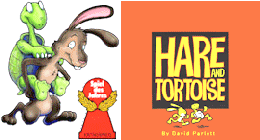
My earliest published game is still available in several editions. Full details
at Hare & Tortoise.

This is the title of a book I was once planning to write but probably now won't get around to. But it's too good a title to waste so I'll use it here to present a survey of all my published games from 1974 to date.

My earliest published game is still available in several editions. Full details
at Hare & Tortoise.
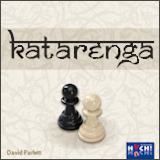
My latest is a two-player strategy game with Chess moves, though it's not a Chess variant as such. Its 8x8 board has squares in four different colours and consists of four double-sided quarter-boards that can be rearranged in thousands of different ways. White and Black each have eight pawns and aim to get two of them across to their opponent’s back rank and then off the board before they can be captured. A pawn moves according to the colour of the square it stands on. From red, it moves like a rook; from yellow, like a bishop; from green, like a knight; from blue, like a king. Its original name was Colorado, suggesting its colourful nature, but the publisher changed it to something referencing Chaturanga, the ancestor of Chess. The same equipment and rules of movement serve for a range of chessboard-type games from the deceptively simple to the fiendishly complex.
Rules of main and variant games at Katarenga.
Published by Huch Spiele, distributed in UK and France by
Asmodee, demo at
YouTube.
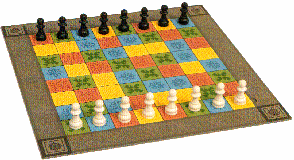
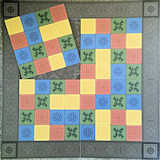
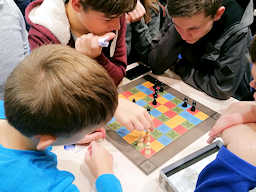
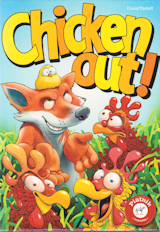
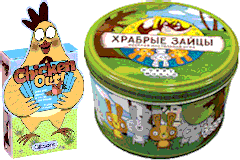
A card game won by the first to play out all their cards. The cards show different numbers of chickens and you turn them one by one from the top of your hand, adding them up as you go. If you bring make the total exactly 21 you sweep them aside and play out as many more as you like, but if you 'bust' you must take all the cards played and add them to your hand. If you’re frightened of busting you can ‘chicken out’ instead, and then get rid of some more. Foxes are jokers that sometimes help and sometimes catch you out. Not a game of great skill, but more fun the faster you play. Chicken Out! has won a Creative Play award from Toy World (category: Indoor Games 8-11 years). It's based on my original card game Bravado played with a standard pack. The Russian version, with circular cards, features hares instead of chickens (so I call it Scaredy-hare).
Shown here are the editions by Piatnik, Gibsons, and Hobby World.
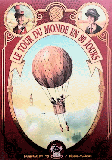
This new(ish) game has occasioned some discussion in BoardGameGeek, as it uses the
same mechanism as Hare & Tortoise and several correspondents have been wondering
whether it counts as a new game or as another iteration of H&T. There's a good
explanation for this. The idea of using this mechanism was suggested to me by
Benoît Forget of
Purple Brain Creations,
as the next in their series of
games based on the classics. (They already did their own version of Hare &
Tortoise some years ago!) I increased the number of squares from
64 to 80 (obviously) and slightly rearranged them to ensure balance and playability.
Benoît added other
ideas, including yet another way of dealing with the equivalent of hare squares.
Launched at Essen in 2016 and published by Asmodee.
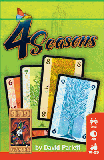
A themed-up version of my trick-taking card game
Ninety Nine, published
(appropriately enough) by the Dutch company
999 Games. It was first
shown in 2016 at the Spellenspektakel
gaming event at Eindhoven.
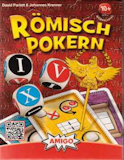
So-called 'Roman Poker' (it's not really a form of Poker) is all that remains of a Roman chariot race game called Right Round Rome, which half a dozen manufacturers liked enough to play-test extensively before deciding that it was too complicated. So I ditched the board and concentrated on devising several mathematical games to play with the dice alone. Johannes Krenner, of White Castle Games, added some Joker cards to turn it into a longer and more of a family game for two to six players.
Published by Amigo. A French version
(AVÉ - Ils sont fous, ces Romains!" is available from
Gigamic and an Italian
("Poker Romano") edition from Giochi Uniti.
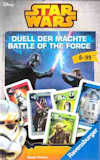
Card game published by Ravensburger
as part of a series of Star-Wars-themed games. It's based on a mechanism
of mine that has already appeared in different guises according to the current franchise.
The Ravensburger edition does not include rules in English, but they can be seen at
www.parlettgames.uk/gamepie/duel.pdf
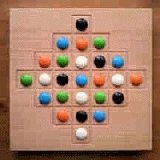
Twenty-five pieces (five each of five different colours) are drawn at random from a box or bag. The first four go in each of the four corners. Each piece subsequently drawn must be placed next to one already in position. You win by so placing all 25 that no two of the same colour are next to each other, whether horizontally, vertically or diagonally. Illustration shows one of thousands of possible solutions.
Originally published 1982 by Skirrid International, more recently by
Gerhards Spiel+Design with
additional rules for playing a competitive two-player game. (Publication
ceased in 2019 on grounds of cost).
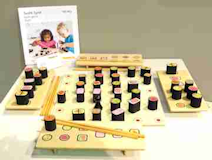
A game of mine originally called Chinese Take-Away has been beautifully converted by
Dusyma into its Japanese
equivalent, with dishes formerly represented by flat tiles now replaced by solid wooden pieces
more easily picked up with chopsticks (provided!). The basic game for two to four players is
a balance of about 60% chance and 40% skill. Dusyma has added a number of variations suitable for
children of all ages, in keeping with the company's educational and didactic specialisms.
In fact Dusyma is primarily not a games publisher as such but a designer, manufacturer and
distributor of educational equipment for German schools and kindergartens.
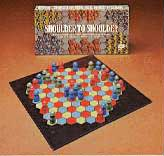
Having always enjoyed three-player card games I wanted to turn my attention
to a three-player board game. The
aim is to be the first to get all 12 of your own pieces together in a
single connected group. It was published in 1975 by Intellect Games, who named
it after a now long-forgotten television series about suffragettes. I
privately renamed it "Solidarnosć" and subsequently "Mob Rule". Click here for
rules and detailed description (in new window).
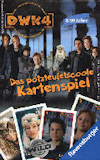
I wouldn't go out of my way to invent a card game relating to football, which
is undoubtedly my least favourite game of all time. But when in 2007 Ravensburger
published a card game based on the fourth of a popular series of films about
a team of fantasy football players known as Die Wilden Kerle
(The Wild Kids), I couldn't resist their invitation to supply a mechanism
for it...

Waddingtons Games made an unusually nice production of this authentic
translation into cubes of a game normally played with spherical objects
(balls to you). It was promoted in 1981 by six-times world Snooker champion
Ray Reardon, who probably made more out of it than I ever did.
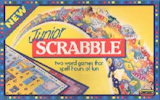
In the late eighties the late Spears Games commissioned me to revise their Junior version of
Scrabble, which was previously played with unnumbered tiles on a rather plain
board. So I coloured the letter squares and devised a scoring system
that didn't depend upon individual letter values.
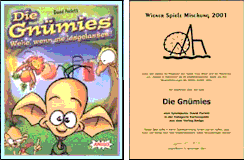
This card game for 2 to 5 players was based on characters from the planet
Gnüm, discovered
by German TV astronauts in the early nineties - and bearing little relation
to the original prototype I sent them, which was called "Hunt the Dinosaur".
Published by Amigo Games,
with an English-language edition from
Rio Grande Games,
it was awarded a Certificate of Merit (illustrated) at the 2001 Vienna Mixed Games
Festival.
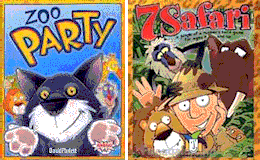
A card game for 2 to 6 players
published in 2000 under the title Alles für die Katz by
Amigo Games. It was
originally called "Chimpanzoo" when I invented it donkeys' years
ago. Players build up a "zoo" in which no two of the same animal may occupy
the same row or column of enclosures - apart from black cats, which count
against you. It gets trickier as you go along. (Why cats? They were supposed
to be black mambas.
The German phrase means something like "It's the cat that gets the cream".)
Also published in English as Zoo Party by
Rio Grande Games
and as 7Safari from Gamewrights (with hyenas replacing mambas).
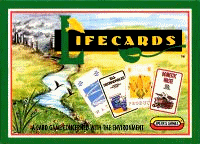
Spears Games commissioned me to devise an "environmentally friendly card
game". It was based on a viciously unfriendly extension of Rummy.
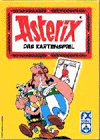
Another Spears commission, also published in Germany (by now defunct F X Schmid)
this rather jolly ancient Gaulish card game is an elaboration of
Gops
A nothing-to-write-home-about elaboration of a mathematical pencil-and-paper game of mine, published in 1982 by Skirrid International as a piece of character merchandising for a long-forgotten children's TV character called Metal Mickey. 'Nuff said.